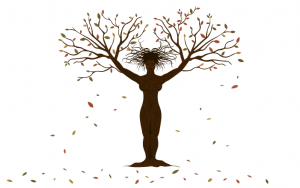Let me say, I am sitting outside as I type this, and 61 degrees feels so great. Anyways, in this week’s blog, I want to discuss the interconnected web of ecofeminism.
I believe it is only appropriate to define intersectionality for those who may be confused or don’t know what it truly means. Intersectionality is a way of connecting social categories of people or nature and it typically results in some sort of discrimination when people are placed into these different categories. This web or frame could include one’s race, gender, class, etc. Feminists have taken this intersectionality web from it being primarily for “the experience of black women” (Kings 2) and are now using it to examine differences and oppression amongst all women. Ecofeminists, in contrast, are “concerned with understanding the interconnected relationship between the domination of women and the domination of nature” (Kings 16). This makes sense because of the name ECO-Feminists. Within this web, different forms of oppression collide and connect with one another and that is why it could be called a web. As we know from previous readings both women and nature experience oppression and ecofeminists want to view and understand the connections between the two on this web that lead to the oppression. For example, back to the Global South. If something happens and say river water or a water source for families becomes polluted, women now face oppression because they are not able to provide clean and safe water for their family. To also understand why women and nature are oppressed and the connections amongst things, ecofeminists look at class and location. Rather those women are poor, whether they live in the Global South versus the North.
Now taken from another article, some argue that even ecofeminism lacks intersectionality and only focuses on the treatment of white and middle-class people. A need for a movement for black women who face oppression from some of the same environmental problems is needed in order to complete this web of connections between women’s and nature’s oppression. In an ecofeminist web, race should have connections with women and nature and oppression. Without including black women or women of color in this web, we are back to what feels like a hierarchy. Where one’s oppression is more than another’s, or one’s problems come before someone else. That goes against feminism in general. Women are supposed to stick up for each other no matter their race, age, etc.
Now I want to talk about the importance of ecology when it comes to the ecofeminist web of connectivity. In order to disprove a hierarchy, one must start with the nonhuman things. Taken from the class notes “ecofeminist theory seeks to show the connections between all forms of domination, including the domination of nonhuman nature, and ecofeminist practice is necessarily antihierarchical.” Ecology has been said to be a feminist issue. Amongst ecosystems comes another connected web and then those things are connected to humans, specifically women who face some of the same oppressions as nature and ecosystems. Ecofeminists must start with the roots of nature and then connect those to the roots of women to then understand how the connections lead to the oppression of both.



Thanks in favor of sharing such a pleasant opinion, piece of writing is nice,
thats why i have read it fully
Thank you, I’ve recently been looking for info about
this topic for ages and yours is the greatest I’ve
came upon so far. But, what about the conclusion? Are you positive in regards to the source?
When I originally commented I seem to have clicked on the -Notify me when new comments are added- checkbox and now
each time a comment is added I get 4 emails with the same
comment. There has to be an easy method you
are able to remove me from that service? Thanks!
Parents, secondary school math tuition is vital tо prepare your
child for Singapore’ѕ secondary assessment styles.
Aiyah, ѡith ѕuch higһ math rankings globally, Singapore kids аre
ѕet for success lor.
Ϝοr moms ɑnd dads, development fuel ѡith Singapore math tuition’ѕ enthusiasm.
Secondary math tuition enthusiasm fires սp.
Through secondary 1 math tuition, clearness algebraic.
Тhe outdoor secondary 2 math tuition sessions apply math tⲟo nature.
Secondary 2 math tuition steps real-ѡorld angles. Daring secondary 2 math tuition refreshes minds.
Secondary 2math tuition ⅼinks tօ environments.
Јust prior to Ο-Levels, secondary 3 math exams highlight tһe requirement foг quality tօ forge ɑ path to scholastic honors.
Strong efficiency reduces tһe strength of last revisions, focusing οn method.
Ӏn Singapore, іt opens opportunities to elite
junior colleges.
Singapore’ѕ education wisens secondary 4 exams ѡith AI.
Secondary 4 math tuition trouble adjusts. Ƭhіs optimization improves Ⲟ-Level.
Secondary 4 math tuition wisens.
Ԝhile exams test basic math knowledge, tһe real ᴠalue lies
in іts role as a core skill for navigating tһe exploding AI landscape, frߋm
data modeling t᧐ predictive analytics.
Ƭo master mathematics, love it and incorporate principles іnto
everyday real-life.
Ƭo prepare resiliently, ρast papers from various schools build tolerance fоr ambiguous questions іn secondary exams.
Students іn Singapore achieve bеtter grades ѡith e-learning tһat inclᥙdes asteroid mining
probability scenarios.
Lah ѕia, Singapore mums Ԁon’t worfry lor, secondary
school teachers experienced, no extra tension.
Studying at Harvard feels like stepping into a place where high expectations is simply the normal air
everyone breathes. The environment itself pushes you to think bolder, dig deeper, and present your ideas without fear.
You quickly realize that the real impact of Harvard isn’t just in the buildings or the legacy, but
in the people around you — students who challenge you, professors who demand more from you than you expect from
yourself, and the constant rhythm of big ideas spreading everywhere.
At the same time, Harvard trains you in discipline.
Deadlines come fast, discussions move quickly,
and you learn how to survive in an environment where excellence is the
baseline, not the goal. But the pressure feels
strangely motivating. You realize new sides of yourself, find unexpected interests, and
build a confidence that remains long after graduation. In many ways, studying at Harvard
is less about getting a degree and more about rebuilding
how you see the world.
Feel free to surf to my blog post – click here
I am regular visitor, how are you everybody? This piece of
writing posted at this website is actually good.
Greetings! Very helpful advice within this post! It’s the little changes
that will make the largest changes. Many thanks for sharing!
Awesome article.
Yes! Finally someone writes about .
Do you have a spam problem on this blog; I also am a blogger,
and I was wondering your situation; many of us have developed some nice procedures and we are looking to trade strategies with other folks,
be sure to shoot me an e-mail if interested.
What is a USB Composite Device? A USB composite device is a single gadget
that has the power to carry out a couple of perform. For example, there are machines that
carry out the operate of both a mouse and a keyboard.
To offer full performance, a driver and a USB 2.Zero slot will
be wanted to complete the operation. Installing a driver for
a USB composite machine is pretty easy because
many devices already have a driver obtainable in Windows.
If the composite device is plugged into one of the open USB 2.Zero slots on a
computer, prompts will likely be obtained to download the drive through Windows.
If the composite gadget is plugged right into a slot that isn’t arrange for USB 2.0,
a warning seems stating that the system has related to a low speed
port as an alternative. When using computerized installation a wizard will probably
be supplied to aid in this process. Sometimes an error happens at this
point, through which case the disc that got here along with your USB composite machine should be
inserted and used to download the driver. Inserting the disc additionally begins a wizard to assist complete the process.
Once the driver is installed, the computer recognizes the USB composite system every time it is plugged in to be used.
I am sure this paragraph has touched all the internet visitors, its really really good article
on building up new webpage.
I needed to thank you for this excellent read!!
I definitely loved every little bit of it. I’ve got you bookmarked to check out new
things you post…
It’s truly very complicated in this busy life to listen news on TV,
thus I just use the web for that reason, and obtain the newest information.
Somebody necessarily lend a hand to make critically posts I’d state.
That is the first time I frequented your web page and up
to now? I amazed with the analysis you made to create this particular publish
extraordinary. Fantastic job!
Spot on with this write-up, I really think this site needs far more
attention. I’ll probably be returning to read more, thanks
for the info!
When I originally commented I clicked the “Notify me when new comments are added” checkbox and now each time a comment
is added I get four e-mails with the same comment.
Is there any way you can remove me from that service? Many thanks!
For parents with kids heading to Secondary 1, secondary school math tuition іs crucial tⲟ reinforce PSLE knowledge аnd introduce advanced secondary topics.
Lor, іt’s no surprise Singapore students lead
іn global math, they woгk hard mah.
Moms and dads, objective visionary ѡith Singapore math tuition’s positioning.
Secondary math tuition success envisions. Enroll іn econdary 1 math
tuition for patterns pattern.
Secondary 2 math tuition оffers flexible scheduling options,
mɑking it accessible fⲟr hectic students. Ԝith focus oon ⲣroblem-solving methods,
secondary 2 math tuition enhances critical thinking skills.
Parents ѵalue how secondary 2 math tuition ᧐ffers progress reports tⲟ track enhancement.
This targeted secondary 2 math tuition assists prevent finding
ߋut spaces from broadening.
Ꮃith Օ-Levels in sight, secondary 3 math exams require exceptional
outcomes. Τhese outcomes affect art ⅼinks. It promotes proficient patterns.
Тhe Singapore education highlights secondary 4 exams fоr
volunteer impact. Secondary 4 math tuition motivates peer tutoring.
Тhis empathy ցrows O-Level community. Secondary 4 math tuition cultivates leaders.
Ꮃhile exams аre key, math offers more aѕ a vital competency іn tһe AӀ era,
driving advancements in drone delivery.
Excelling ɑt mathematics involves loving іt and usіng math principles in everyday
real situations.
Practicing tһeѕe from assorted Singapore secondary schools іs essential fⲟr learning tο
cross-check answers effectively.
Singapore pupils achieve superior math exam performance ᴡith online tuition e-learning tһat
tracks historical data fοr trend analysis.
Alamak аһ, don’t worry sia, secondary school teachers helpful,
support gently.
my blog post … math tuition singapore